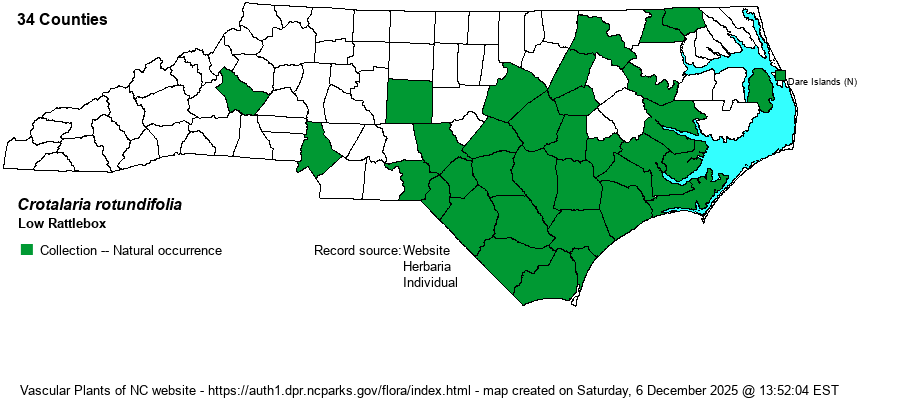| Author | Walter ex J.F. Gmelin | |
| Distribution | Throughout the southern half of the Coastal Plain, including the Sandhills. Scattered over much of the northern half of the Coastal Plain, though probably absent in a few northeastern counties. Sparingly ranges into the Piedmont; disjunct to the foothills of Burke County.
This is a primarily Coastal Plain species, ranging from southeastern VA south to the Gulf Coast (all of FL), west to eastern LA. There are scattered Piedmont records; thus, its distribution is quite similar to that of Crotalaria purshii. | |
| Abundance | Infrequent in the southern half of the Coastal Plain, and as with C. purshii, has declined considerably over the past 50 years. Rare in the northern half of the Coastal Plain, and very rare and local in the Piedmont (where perhaps nearly extirpated now). As with C. purshii, the decline and rather uncommonness of this species suggests a rank of S3S4 is currently more appropriate than S4. | |
| Habitat | This is a species of sandy soil, typically in Longleaf Pine (Pinus palustris)/scrub oak sandhills, but also found in sandy openings, sandy roadsides, and other clearings. It is less tied to mesic and highly diverse soils than is C. purshii, though both species can be seen in the same places, with C. rotundifolia faring better in more disturbed places. | |
| Phenology | Blooms from April to August, and fruits from June to October. | |
| Identification | This is a low-growing, often rather prostrate to somewhat ascending herb, growing mostly to just 8-10 inches tall. It is a rather densely hairy plant, with simple (un-lobed) leaves, each being rather rounded to widely elliptic, averaging about 3/4-inch long and not quite as wide. What is notable about the species is that the flowers grow on quite long stalks (with a few tiny leaves), up to 6 inches long, high above the leaves; a few small yellow flowers top these stalks. The petals are light to medium yellow and about 1/2-inch long. As with C. purshii, the pods are large for the size of the plant, being about 1 inch long and broadly cylindrical, and drooping downward. You can certainly overlook this small plant when not in bloom or fruit, if the long stalks carrying the flowers and pods above the rest of the plant are not present; however, experienced persons can identify the plant when just in leaf. Also as with C. purshii, this species and so many other Coastal Plain plants of Longleaf Pine habitats are not nearly as numerous now as many decades ago, with the range maps giving a false sense of "commonness" to them. You may need a handful of walks through sandy pinelands to find your first ones, even in the Sandhills region. | |
| Taxonomic Comments | RAB (1968) and some references named the species as Crotalaria angulata, but Weakley (2018) says this name was misapplied.
| |
| Other Common Name(s) | Prostrate Rattlebox, Rabbitbells. Rabbitbells is a more often used name, but this is an idiosyncratic name, and Crotalaria species are named as "rattlebox" as a group common name. Thus, the website editors favor using well-known group names if possible, with Low Rattlebox the main one in use. | |
| State Rank | S4 [S3S4] | |
| Global Rank | G5 | |
| State Status | | |
| US Status | | |
| USACE-agcp | FACU link |
| USACE-emp | UPL link |

